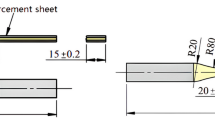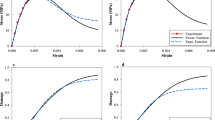Abstract
A three-dimensional (3D) Finite element (FE)-based progressive damage model, which considers the interface matrix layer between two neighboring laminae as a layer of cohesive elements, is proposed to analyze laminated composite plates. An elasto-plastic damage model is integrated with the FE-based program ABAQUS that uses user-defined material subroutine. The present damage model includes fiber failure, matrix failure, and delamination effects. A cohesive zone model, which is available in ABAQUS and uses cohesive elements, is combined with the proposed model to address the delamination damage in the interface layers. 3D solid brick elements are used to model composite layers, and cohesive zone elements are used in between two composite layers to model the adhesive layers. The proposed model has been applied for the progressive damage simulation of AS4/PEEK composite laminates under in-plane and uniaxial tensile loading.
Similar content being viewed by others

References
R. J. Nuismer and J. M. Whitney, Uniaxial failure of composite laminates containing stress concentrations, ASTM STP, 593 (1975) 117–142.
J. Backlund and C.-G. Aronsson, Tensile fracture of laminates with holes, J. Compos. Mater., 20 (1986) 259–286.
A. Afaghi-Khatibi, L. Ye and Y.-W. Mat, An effective crack growth model for residual strength evaluation of composite laminates with circular holes, J. Compos. Mater., 30 (1996) 142–163.
F.-K. Chang and K.-Y. Chang, A progressive damage model for laminated composites containing stress concentrations, J. Compos. Mater., 21 (1987) 834–855.
I. Shahid and F.-K. Chang, An accumulative damage model for tensile and shear failures of laminated composite plates, J. Compos. Mater., 29 (1995) 926–981.
L. B. Lessard and M. M. Shokrieh, Two-dimensional modeling of composite pinned-joint failure, J. Compos. Mater., 29 (1995) 671–697.
I. Lapczyk and J. A. Hurtado, Progressive damage modeling in fiber-reinforced materials, Compos. Part A Appl. Sci. Manuf., 38 (2007) 2333–2341.
P. Maimí, P. P. Camanho, J. A. Mayugo and C. G. Dávila, A Continuum damage model for composite laminates: Part II-Computational implementation and validation, Mech. Mater., 39 (2007) 909–919.
J. F. Chen, E. V. Morozov and K. Shankar, A combined elastoplastic damage model for progressive failure analysis of composite materials and structures, Compos. Struct., 94 (2012) 3478–3489.
F. P. Van Der Meer and L. J. Sluys, Continuum models for the analysis of progressive failure in composite laminates, J. Compos. Mater., 43 (2009) 2131–2156.
R. H. Maa and J. H. Cheng, A CDM-based failure model for predicting strength of notched composite laminates, Compos. Part B Eng., 33 (2002) 479–489.
W. Van Paepegem, I. De Baere and J. Degrieck, Modelling the nonlinear shear stress-strain response of glass fibrereinforced composites. Part I: Experimental results, Compos. Sci. Technol., 66 (2006) 1455–1464.
J. Wang, P. J. Callus and M. K. Bannister, Experimental and numerical investigation of the tension and compression strength of un-notched and notched quasi-isotropic laminates, Compos. Struct., 64 (2004) 297–306.
M. C. Lafarie-Frenot and F. Touchard, Comparative inplane shear behaviour of long-carbon-fibre composites with thermoset or thermoplastic matrix, Compos. Sci. Technol., 52 (1994) 417–425.
ABAQUS Version 6.12, Dassault Systèmes Simulia Corp., © Dassault Systèmes, Providence, RI, USA (2012).
ABAQUS Documentation, Version 6.12, Dassault Systèmes Simulia Corp., Dassault Systèmes, Providence, RI, USA (2012).
P. Linde, J. Pleitner, H. De Boer and C. Carmone, Modelling and simulation of fibre metal laminates, ABAQUS Users’ Conf. (2004) 421–439.
W. Ramberg and W. R. Osgood, Description of stressstrain curves by three parameters, Tech. Note No. 902 (1943) 1–13.
J. F. Chen, E. V. Morozov and K. Shankar, Simulating progressive failure of composite laminates including in-ply and delamination damage effects, Compos. Part A Appl. Sci. Manuf., 61 (2014) 185–200.
M. Naderi and M. M. Khonsari, Stochastic analysis of inter-and intra-laminar damage in notched PEEK laminates, Express Polym. Lett., 7 (2013) 383–395.
Author information
Authors and Affiliations
Corresponding author
Additional information
Recommended by Associate Editor Jin Weon Kim
Bibekananda Mandal is presently a Research Scholar at the Indian Institute of Technology, Roorkee, India. His research areas include finite element analysis of laminate composite plates, FRP bridge decks, FRP joints, and stochastic dynamic analysis of laminated composite plates.
Rights and permissions
About this article
Cite this article
Mandal, B., Chakrabarti, A. Elasto-plastic damage model considering cohesive matrix interface layers for composite laminates. J Mech Sci Technol 32, 121–127 (2018). https://doi.org/10.1007/s12206-017-1213-y
Received:
Revised:
Accepted:
Published:
Issue Date:
DOI: https://doi.org/10.1007/s12206-017-1213-y



